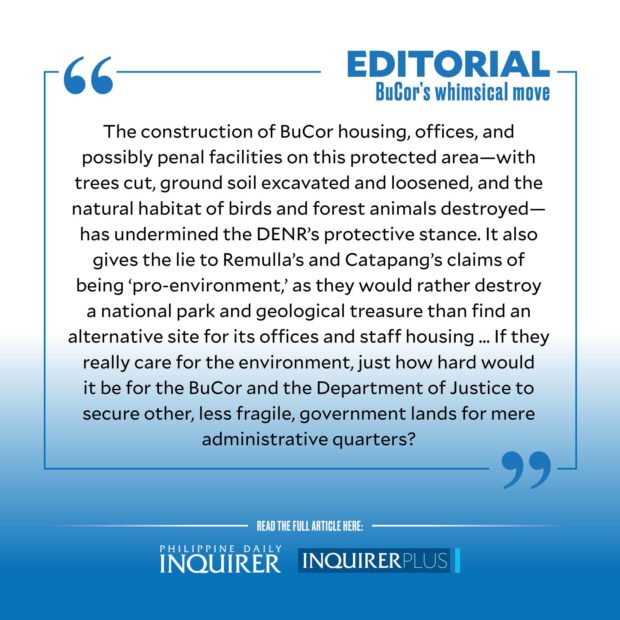Why are environmental groups up in arms over the Bureau of Corrections’ (BuCor) proposed plan to relocate its offices, administrative facilities, and staff housing to a portion of the Masungi Georeserve in Baras, Rizal? Are they just being “alarmist,” as Justice Secretary Jesus Crispin Remulla has described them?
At first glance, the plan seems aboveboard and reasonable enough. After all, the site being eyed is government-owned land and was awarded to the bureau through a 2006 proclamation of then President Gloria Macapagal Arroyo. There also seems to be ample space in this 1,600-hectare conservation area, some 47 kilometers east of Manila, for the 270-ha intended site of the BuCor headquarters. Currently, BuCor is sitting on 254.73 ha of the 551-ha New Bilibid Prison (NBP) compound in Muntinlupa City.
BuCor acting chief Gregorio Catapang Jr. said the proposal to relocate to Rizal province was part of the agency’s five-year development plan approved in line with the Philippine Development Plan 2023-2028 of President Marcos Jr. A separate NBP Master Development Plan based on Arroyo’s 2006 proclamation would meanwhile convert the remaining 366.7 ha of the NBP reservation into a mixed-use complex that would generate funds for the national government, he added.
Addressing fears that relocating prison facilities in this protected area could present security problems for nearby residential communities, Catapang said that only the BuCor offices and not the penitentiary building would be transferred.
Despite the reassurances and clarifications, a general sense of unease and disbelief continues to cast doubts on the soundness of the BuCor plan and the integrity of its intention. Why, for one, would the agency need an onsite agro-production area supposedly to sustain their “basic institutional food requirements” if only the BuCor staff would be transferred from Muntinlupa? And who would tend the agro fields if prison inmates are not part of the relocation, as Catapang consistently claims? There were also no details about how many housing units will be built for the BuCor personnel, and how living there would impact the fragile environment.
That NBP facilities would most likely be relocated to the site can be gleaned as well from Remulla’s defense of the proposed transfer, saying it was in line with the justice department’s plan to build regional prison facilities to decongest its Muntinlupa facilities. The choice of location was within the agency’s mandate to improve the country’s penal management system, he stressed.
While a trustee of the Masungi Georeserve Foundation Inc., the government-designated caretaker of the geopark since 2017, has brought up the site’s mountainous terrain as being unsuitable for the construction of BuCor housing and offices, the more critical issue on the relocation plan is its impact on the environment. Masungi Georeserve was declared a protected area in 2011 by then President Benigno Aquino III.
Ironically, the BuCor’s proposed move was announced just days after a coalition of environmental groups scored a “major victory” when the Department of Environment and Natural Resources (DENR) last week ordered the cancellation of the quarrying permits of three companies within the Upper Marikina River Basin Protected Landscape and the Masungi Geopark Project.
In a statement, the Upper Marikina Watershed Coalition described the protected area as being home to a diverse population of flora and fauna, and as the ancestral land of the indigenous Dumagat-Remontado community. It added that the DENR action would not only preserve their cultural heritage, but was also a significant step toward the conservation and protection of the ecological services and natural resources of the Upper Marikina watershed. Together with the Kaliwa Watershed Forest Reserve, it is instrumental in “regulating the flow of water” toward Metro Manila, the group said. “We stand to lose a geological heritage,” added Masungi Foundation trustee Ann Dumaliang of the georeserve that straddles the rocky spine of the southern Sierra Madre mountain range.
Alas, the construction of BuCor housing, offices, and possibly penal facilities on this protected area—with trees cut, ground soil excavated and loosened, and the natural habitat of birds and forest animals destroyed—has undermined the DENR’s protective stance.
It also gives the lie to Remulla’s and Catapang’s claims of being “pro-environment,” as they would rather destroy a national park and geological treasure than find an alternative site for its offices and staff housing. It behooves the DENR to make a stand on this whimsical move in order to protect a vital ecosystem. If they really care for the environment, just how hard would it be for the BuCor and the Department of Justice to secure other, less fragile, government lands for mere administrative quarters?


